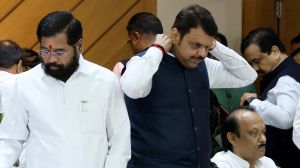On Monday (August 11), US President Donald Trump extended his country’s tariff truce with China for an additional 90 days, till November 10. Discussions between senior officials in Stockholm in late July had previously hinted at another extension, even as higher US tariffs have been imposed on several countries of late, including India.
However, that doesn’t mean all is smooth sailing in China-US trade, and the race for dominating the artificial intelligence domain saw something quite unusual this week. The Financial Times reported that the US government allowed the semiconductor giant Nvidia to sell previously restricted AI chips to China, if they agreed to pay a certain percentage of the sale to the government.

Last week, we noted the reports of Prime Minister Narendra Modi likely visiting China next month for the Shanghai Cooperation Organisation (SCO) summit. Now, Chinese Foreign Minister Wang Yi is expected to visit India on August 18 for the Special Representative-level talks (the SR mechanism is for discussing border issues) with National Security Advisor Ajit Doval.
The Wall Street Journal also reported this week that Liu Jianchao, a key Chinese diplomat, was picked for questioning by authorities. Then on Friday, Reuters reported that a deputy to Liu, Sun Haiyan, was also detained. We wrote about Liu and what such ‘disappearances’ say about the Chinese establishment here.
Bloomberg also reported that amid the greater bilateral engagements under the recent normalisation in India-China ties, direct flights may be resumed soon.
Here is a closer look at these developments:
1. US-China tariffs pause
A statement from the White House said that the tariff pause will provide time for “remedying trade imbalances” and “unfair trade practices”. “Each round of negotiations with the Chinese has built on each other… to work toward fair and balanced trade with a key trading partner,” it said.
Trump was also quoted as saying, “We’re getting along with China very well.”
Story continues below this ad
UPSHOT: An editorial in the Chinese Communist Party (CCP) mouthpiece Global Times appreciated the development: “This shows that China and the US are managing differences and expanding cooperation in an equal, pragmatic and constructive way.”
That high tariffs were unsustainable in the long run was clear from the get-go, but many assumptions have been proven wrong. For example, the US has been the one to repeatedly ask China to come to the negotiating table, and China has been the only nation to counter with its own tariffs on the US — indicating both the intention and ability to challenge its actions.
Simultaneously, the latest US economic data shows inflation remained moderate, despite the initial fears of American consumers quickly being impacted. There are several reasons for this, like the eventual lowering of tariff rates, but the prevalent view remains that the effects will show at some point. As the GT article noted, “Data shows that China’s exports to the US have declined for four consecutive months.” It would thus make sense for both sides to push for a settlement.
2. Nvidia’s H20 chips in focus over China-US AI race
Almost exactly a month ago, Nvidia chief Jensen Huang visited China. Around the same time, the company announced it was filing applications “to sell the NVIDIA H20 GPU again”, saying the US government assured it of requisite licenses.
Story continues below this ad
Now, Nvidia has agreed to pay the US government 15 percent of the money made from selling H20 chips to China, the FT reported on Monday. Another US chipmaker, AMD, will do the same for its MI308 chip revenues. Altogether, the deal was estimated to bring about $2 billion to the government, The New York Times said.
UPSHOT: The US government restricted both these chips in April this year, over concerns that they would help accelerate the pace of AI development in China, and their potential military applications.
This was seen as a progression of the Joe Biden-era restrictions on advanced AI chips being sold to China. In fact, the lower-quality H20s were designed to circumvent the directive. Huang had previously argued for allowing the sale, saying it was causing a US company to lose market share and allowing Chinese companies like Huawei to fill the gap. However, critics argued that China would stand to gain a significant strategic advantage with Nvidia products.
This is also why the latest deal has been described as “unprecedented”. Liza Tobin, a China expert who served on the National Security Council in the first Trump administration, told the FT, “What’s next — letting Lockheed Martin sell F-35s to China for a 15 per cent commission?”
Story continues below this ad
Notably, China has previously demanded the entry of H20s, but it may be changing its stance now, given its indigenous push to become self-reliant. A state media-affiliated author recently wrote an article criticising the H20. “When a type of chip is neither environmentally friendly, nor advanced, nor safe, as consumers, we certainly have the option not to buy it,” he wrote. The country’s cyberspace regulators also summoned Nvidia officials “over concerns that its H20 artificial intelligence computing chips could be tracked and turned off remotely”.
3. Wang Yi’s visit, report on direct flights resuming
Wang Yi is set to visit India next week. Separately, Bloomberg reported on Tuesday that “India and China are set to resume direct flight connections as soon as next month”, citing people familiar with the negotiations. Flights were first restricted amid the Covid-19 pandemic.
UPSHOT: Both developments come amid the larger normalisation process that was officially set in motion last October. It was followed by Prime Minister Narendra Modi and Chinese President Xi Jinping meeting during the BRICS summit in Russia.
Wang’s visit is notable for another reason — it’s the first high-level official visit by a Chinese leader to India after Operation Sindoor. Notably, Pakistani Foreign Minister Ishaq Dar visited China just a few weeks after the conflict with India, where the countries affirmed their “brotherly” and “ironclad” relationship.
Story continues below this ad
However, India and China also have several outstanding bilateral issues, most importantly concerning the Line of Actual Control (LAC) that serves as the de facto border. The 2020 LAC stand-off also contributed to limited flights and visa approvals, as well as people-to-people exchanges.
As The Indian Express earlier reported, in January-October 2024, the total number of flyers (in both directions) between India and China was over 4.60 lakh. This marked a drastic fall from close to a million in the corresponding months of 2019.
Beijing also perhaps expects to benefit from a resumption, as Chinese carriers held a dominant share of the direct flight market before the pandemic. However, Air India and IndiGo would also likely want to capitalise on it if resumption happens.









































